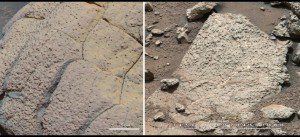
NASA’s Curiosity rover successfully drilled into Martian rock, showing ancient Mars could have supported living microbes.
Scientists identified sulfur, nitrogen, hydrogen, oxygen, phosphorus and carbon — some of the key chemical ingredients for life — in the powder Curiosity drilled out of a sedimentary rock near an ancient stream bed in Gale Crater on the Red Planet last month.
“A fundamental question for this mission is whether Mars could have supported a habitable environment,” said Michael Meyer, lead scientist for NASA’s Mars Exploration Program at the agency’s headquarters in Washington. “From what we know now, the answer is yes.”
The patch of bedrock where Curiosity drilled for its first sample lies in an ancient network of stream channels descending from the rim of Gale Crater. The bedrock also is fine-grained mudstone and shows evidence of multiple periods of wet conditions, including nodules and veins.
Scientists plan to work with Curiosity in the “Yellowknife Bay” area for many more weeks before beginning a long drive to Gale Crater’s central mound, Mount Sharp. Investigating the stack of layers exposed on Mount Sharp, where clay minerals and sulfate minerals have been identified from orbit, may add information about the duration and diversity of habitable conditions.
An additional drilled sample will be used to help confirm these results for several of the trace gases analyzed by the rover’s Sample Analysis at Mars instrument.
“We have characterized a very ancient, but strangely new ‘gray Mars’ where conditions once were favorable for life,” said John Grotzinger, Mars Science Laboratory project scientist at the California Institute of Technology in Pasadena, Calif. “Curiosity is on a mission of discovery and exploration, and as a team we feel there are many more exciting discoveries ahead of us in the months and years to come.”


